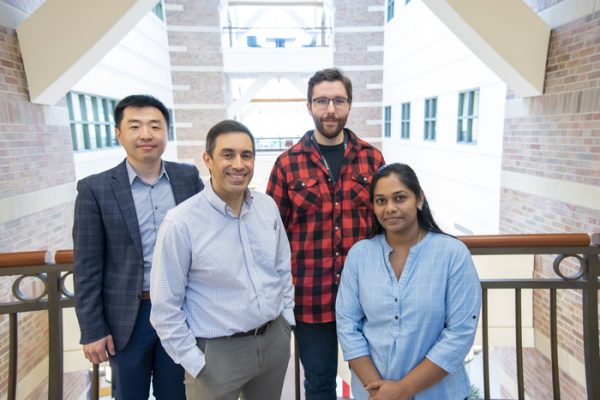
(From left) Pengfei Song, Dr. Dan Llano, Matthew Lowerison, and Nathiya Chandra Sekaran are part of the Beckman Institute for Advanced Science and Technology research team to receive federal funding to develop ultrasound imaging methods for studying the neurovascular changes underlying Alzheimer's disease. Image courtesy of Beckman Institute for Advanced Science and Technology.
July 11, 2022 — Understanding the relationship between Alzheimer’s disease and the brain’s vascular system — its complex network of vessels and veins — is a longstanding challenge for scientists.
“The issue is that there are currently no tools, specifically imaging tools and small animal models, to help study this question,” said Pengfei Song, an assistant professor of electrical and computer engineering and bioengineering at UIUC.
Interdisciplinary researchers at the Beckman Institute received federal funding to develop ultrasound imaging methods for studying the neurovascular changes underlying Alzheimer's disease. Their low-cost, widely accessible technique could eventually aid in the disease’s early detection.
“This collaborative work is only possible at a place like Beckman Institute and will provide a quantum leap in our understanding of how the vascular system impacts Alzheimer’s disease,” said Dr. Dan Llano, an associate professor of molecular and integrative physiology.
Jointly led by Song and Llano, this collaborative project is supported by a two-year, $421,500 R21 grant from the National Institutes of Health designed to fund exploratory and early-stage research.
“Our lab has been looking for ways to do deep-tissue high-resolution imaging for years. We are very fortunate to have been able to forge a collaboration with Professor Song to be able to achieve unprecedented deep-tissue non-invasive brain imaging,” Llano said.
In particular, the researchers seek to understand the directionality of interactions between plaque deposition, microvascular changes, and cognitive impairment, a major challenge in the field.
“There is an interplay between microvascular changes and Alzheimer’s disease. But the exact mechanism, especially the direction of the relationship between microvascular pathology and Alzheimer’s disease pathology, remains elusive. It is a hotly debated area — like a chicken and egg problem,” Song said.
Ultrasound microscopy provides fast, accurate images of animal microvasculature by measuring how small contrast-agent microbubbles travel through the bloodstream. The microbubbles are a helpful imaging technique because they are easier to image and track with ultrasound.
“This ultrasound technology allows us to image the entire brain with a resolution that is high enough to resolve microvessels,” Song said. “Our imaging system is low-cost, mobile, and widely accessible. We believe that if our method gains traction, it may be rapidly adopted by the Alzheimer’s disease community. This imaging combination of penetration and resolution is unprecedented.”
A combination of histology — microscopic anatomy — and cognitive assessments will be deployed in mouse models to validate the tool’s efficacy for studying changes in the brain’s microvasculature.
“Histology is currently considered the gold standard,” Song said. “We can correlate our in vivo ultrasound measurements with the successive ex vivo histology.
“The second approach is to use cognitive testing, deploying standardized cognitive tests like the water maze. In ultrasound, if we see impairments in vasculature that correlate to impairments in cognitive function, that also allows us to measure whether vasculature impairment is involved in cognitive changes. We want to demonstrate to the Alzheimer’s disease community that super-resolution ultrasound imaging is a viable tool and show they can adopt this tool and use it to answer hypothesis-driven questions.”
Efforts to untangle the relationship between microvasculature and cognitive impairment may one day aid in early detection of Alzheimer’s disease.
“This is a classic interdisciplinary collaboration between researchers building imaging tools and neuroscientists with a specific physiology problem they want to answer,” Song said. “This collaboration allows our research group to keep a finger on the pulse of the true application for this technology, so that we can target the existing gap and address it. All these mysteries in Alzheimer’s disease will require tools to solve, and this new tool will provide new insights to this disease.”
The research is supported by Beckman Institute Postdoctoral Fellows Nathiya Chandra Sekaran and Matthew Lowerison.
“We really need to thank Beckman for that tremendous support,” Song said. “Nathiya has a very strong background in neuroscience and animal models. From my lab, Matt brings in animal imaging expertise. They have been doing the hard work collecting data on these projects.”
For more information: https://beckman.illinois.edu/


 December 11, 2025
December 11, 2025 









